Canada continues its climate efforts. At the end of last year, the government decided to ban cars with combustion engines in 2035. A quota for electric cars will already be introduced before then. What is good for global warming is also good for Chinese EV manufacturers, writes Christian Domke Seidel. After all, they offer the affordable cars that have so far been lacking in Canada.
And BYD, NIO & Co. can gain a foothold in the North American market via Canada, where they do not have to fear punitive tariffs on their products. This also shows that the more pioneering competition benefits when the domestic industry does not manufacture the products required for the climate transition.
The Maldives are currently breaking new ground with their alliance partners. The island nation has traditionally felt close to India, but it is now turning to China under its new president, Mohamed Muizzu. This is an enormous geostrategic win for the People’s Republic, as the atolls of the Maldives lie on an underwater ridge that forms a kind of wall in the middle of the Indian Ocean, offering massive potential for controls and blockades, as Michael Radunski explains.
China has lent so much money to the archipelago that it is now its largest bilateral creditor. Its repositioning proves that the investment has paid off.

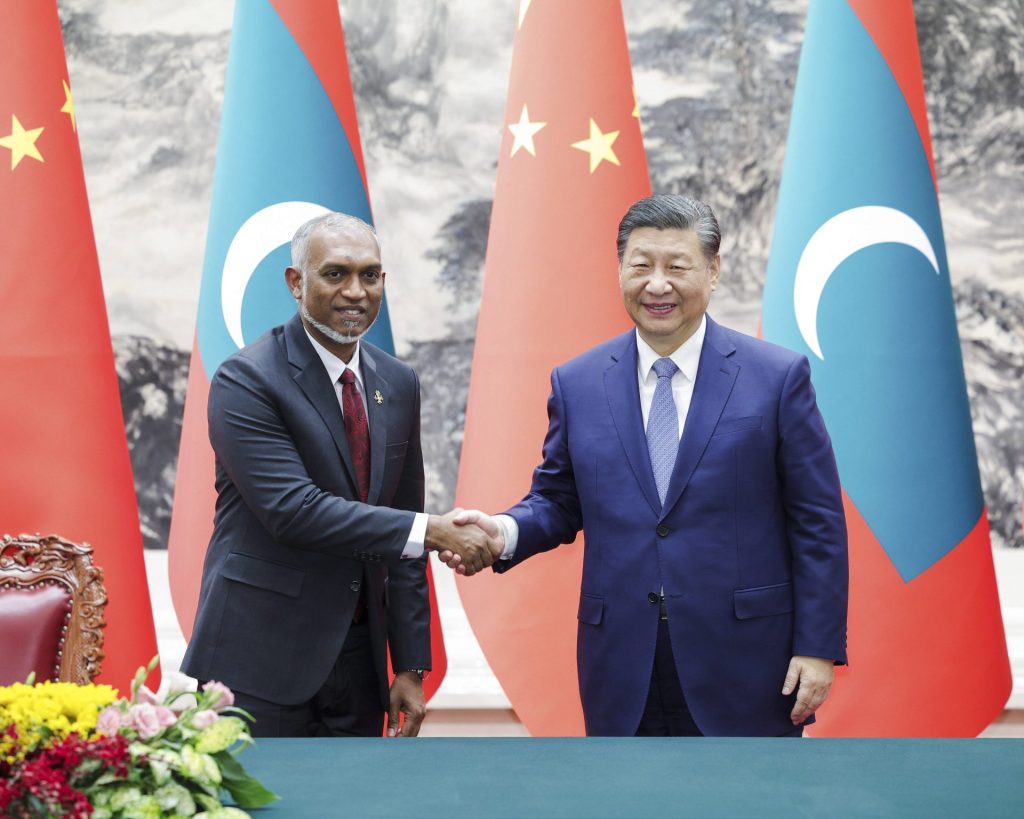
The Maldives has a new strategic partner: China. For years, the small island state in the Indian Ocean maintained close ties to neighboring India. Now, however, Malé looks to the much more distant People’s Republic. This is an important geostrategic gain for China. The Maldives may be small, but they play an important role in the race for influence in the Indian Ocean.
The driving force behind the shift towards China is Mohamed Muizzu. The 45-year-old has been President of the Maldives for a few months now. His election campaign slogan was: India out. Muizzu claimed that Delhi’s traditionally strong influence threatened his country’s sovereignty.
The new president is now putting his words into action – and breaking old traditions in the process. Instead of first traveling to India, he preferred to visit China in early January. In the port city of Fuzhou, he campaigned for investment and called China one of his “closest allies and development partners.” The meeting with party and state leader Xi Jinping resulted in 20 agreements and a comprehensive strategic partnership.
Muizzu’s main focus in China was on:
Shortly after Muizzu’s China trip, his next insult to Delhi came in the form of an ultimatum: India’s military forces, after being stationed in the Maldives for years, must leave the country by mid-March.
This new close partnership is an enormous geostrategic gain for Beijing. This may seem surprising at first glance: The Maldives is the smallest Asian country with a total land area of just 300 square kilometers and a population of just 480,000. However, its atolls are located on a 960-kilometer-long underwater ridge stretching from north to south.
This makes the Maldives a kind of wall in the middle of the Indian Ocean – with enormous control and blockade potential. Some of the most important international shipping routes run through its exclusive economic zone: sea routes crucial for trade between the Gulf of Aden and the Gulf of Hormuz in West Asia and the Strait of Malacca in South East Asia. Among other things, oil is transported here from the Middle East to Asia – to Japan and, above all, to China.
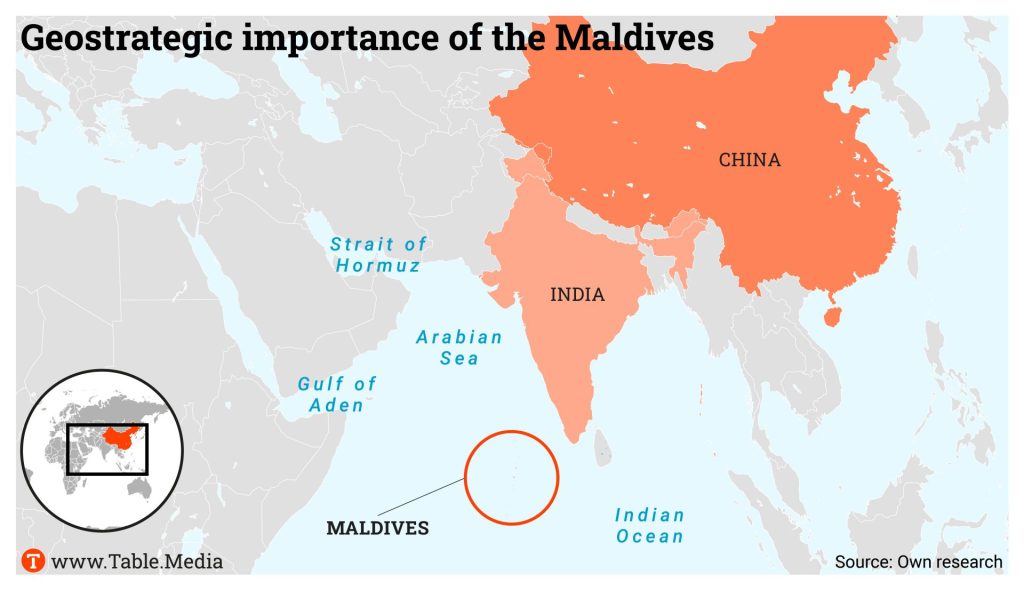
“The Indian Ocean is far from us, but it’s extremely important to the economic and energy security of our country, as well as the Belt and Road Initiative,” Zhao Gancheng from the Shanghai Institute for International Studies told the Chinese Global Times. Since the Maldives joined China’s maritime Silk Road in 2014, companies from the People’s Republic have invested almost 1.4 billion US dollars in the small island nation. This also explains Muizzu’s first stop on his trip to China: Fuzhou is the starting point of China’s Maritime Silk Road.
Chinese loans financed the expansion of the power grid and the international airport, the construction of thousands of homes and a kilometer-long bridge. “The Maldives-China Friendship Bridge, a dream project to local residents over half a century, has become a symbol for the friendliness between the two countries, which has changed the daily lives of Maldivians,” rejoices the Chinese Global Times. According to Reuters, the Maldives now owes China 1.37 billion US dollars for the project. This makes the People’s Republic the island nation’s largest bilateral creditor, ahead of Saudi Arabia and India.
Beijing now aims to play the role of the big ally. This change is very well received there. Xi called Muizzu an “old friend.” As proof of the supposedly long relationship, a commentary by the state news agency Xinhua even refers to navigator Zheng He, whose ships docked in the Maldives during the Ming dynasty. However, Beijing only opened an embassy in the Maldives at the end of 2011 – amid significant domestic political unrest. At that time, it was only possible to restore public order with the help of the Indian military.
Meanwhile, the rejection of Delhi has affected one of the Maldives’ most important industries: tourism. The hashtags #BoycottMaldives and #ExploreIndianIslands are used in India to encourage people to spend their holidays in India instead of in the Maldives. Prime Minister Narendra Modi praised the beauty of Indian beaches earlier this month. The online travel booking company EaseMyTrip has already removed the Maldives from its program. “We’ve put nation before business,” said Prashant Pitti, co-founder of EaseMyTrip, in a television interview. “This is a proxy war between India and China.”
The stakes are high, as most tourists came from India in 2023, accounting for 11.2 percent of all tourists, according to data from the Ministry of Tourism. Followed by Russians and Chinese. However, before the COVID-19 pandemic, travelers from China led the rankings. If President Muizzu has his way, this will be the case again as soon as possible.
From Malé’s perspective, the rapprochement with Beijing has perfectly understandable reasons: The Maldives lost its status as a developing country in 2012. The consequence: The country could no longer rely on international aid for its development plans. While many countries hesitated, Beijing recognized its opportunity.
“The Maldives is trying to get the best out of the rivalry between India and China,” Rajeswari Rajagopalan told Table.Media. “The Maldives is doing what every small player does when you have two big powers in the neighborhood: play them off against each other to get the best deal. It’s a well-known strategy,” explains the researcher from the Observer Research Foundation in Delhi.
Sri Lanka is also located in this neighborhood – a country that has also turned away from India and towards China. Experts criticize China for using its loans to lure Sri Lanka into a debt trap to make the country economically and politically dependent. The World Bank warns that the Maldives’ debt is now unsustainably high.
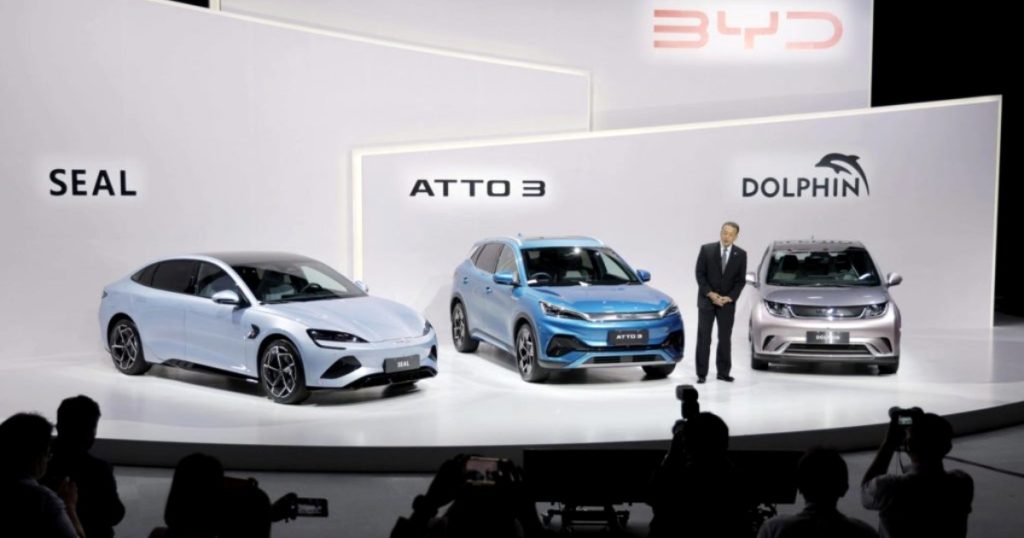
In 2035, new cars that run on gasoline or diesel can no longer be sold in Canada. Due to the lack of domestic alternatives, Chinese manufacturers could close the supply gap. They offer what Canadian customers want: affordable electric cars. BYD has the best chance of gaining a substantial market share.
In late 2023, Canadian Environment Minister Steven Guilbeault presented a law that will ban the sale of new cars with diesel or gasoline engines starting in 2035. The Electric Vehicle Availability Standard serves as a kind of guide for car manufacturers with predefined quotas. By 2026, every fifth vehicle sold is to be purely electric. The percentage then increases continuously: 23 percent in 2027, 60 percent in 2030 and 100 percent in 2035. “Two provinces are already above the 20 percent threshold – Quebec and British Columbia,” Guilbeault said
According to the Canadian Vehicle Information System (CVSI), Canadians bought a total of around 1.8 million cars in 2023. Electric cars accounted for just 12 percent of new registrations. One reason for the low share is the price. The Canadian Black Book – a mobility data provider in Canada – reports that the average price of a new car last year was 66,000 Canadian dollars (around 45,000 euros) but, prices for an EV averaged 73,000 dollars (about 49,700 euros).
John Fanjoy, an analyst at Scotiabank, explains in an interview with the Canadian Broadcasting Corporation (CBC): “We found that vehicle prices would need to come down by about a third to even half of what they are today, in relative purchasing power terms, in order for electric vehicles to be affordable mass market.” The high average price is also because American and European manufacturers mainly offer EVs in the premium segment.
The situation is different in China, where BYD, for instance, targets the volume segment with its EVs. And this is precisely why the Canadian law on phasing out combustion engines has many dealerships and representatives of the North American automotive industry worried. Flavio Volpe, President of the Canadian Automotive Parts Manufacturers’ Association, called the plans unachievable: The Canadian government doesn’t care whether the cars come from Canada or China. He believes that the legislative initiative is harmful to the Canadian industry.
Noel Hiscox, President of the Canadian automotive consultancy Clarify Group, spoke more cautiously to CBC, but no less clearly. There is a chance that the need to change quickly will open up the market for Chinese manufacturers in a way that would not happen with a slower approach.
So far, the Canadian car market has been heavily dependent on the United States – around three-quarters of new cars come from there. This is also reflected in the registrations. The best-selling vehicles are SUVs (711,000) and pickups (387,000), with the most popular brands being Honda, Toyota, Ford, Hyundai and Chevrolet. Most of them are being manufactured in the United States.
However, even before the combustion engine ban, Chinese car manufacturers recognized the opportunity the Canadian market offers them. While the United States imposes a 25 percent punitive tariff on assembled Chinese cars, this does not apply in Canada. Although Tesla models from Shanghai have primarily been exported to Canada so far, BYD and NIO have also been ready for a long time.
Although the manufacturers tend to be tight-lipped when speaking to Table.Media, a NIO representative made it clear with regard to Canada: “As a global smart EV company, NIO is continuously looking at expanding into other markets, which of course includes North America.”
BYD is already one step ahead. The company, which recently replaced Tesla as the world’s largest EV manufacturer, has already built a plant for electric buses in Ontario in 2023. Ted Dowling, Vice President of BYD Canada, showed hardly any reservations during its opening. “We’re proud to establish a home in Canada; it re-affirms our commitment as a company to be rooted in this country and in this province.”
Canada plays a vital role in the efforts of many companies and countries to become less dependent on China. The country has an abundance of lithium, cobalt, nickel and graphite. Mercedes and VW have already signed a memorandum of understanding to examine the extent to which Canada can help build a global battery supply chain.
Honda has also knocked on Canada’s door and plans to invest the equivalent of 12.5 billion euros to build a battery and EV plant in Canada. Production is scheduled to begin in 2028. In addition, Northvolt, Volkswagen and Stellantis have pledged investments of around 25 billion euros over the next ten years.
Yasutoshi Nishimura, Japan’s Minister of Trade and Industry, also visited Canada in 2023 to agree on closer cooperation in the field of electromobility. A meeting that focused primarily on Canada’s natural resources.
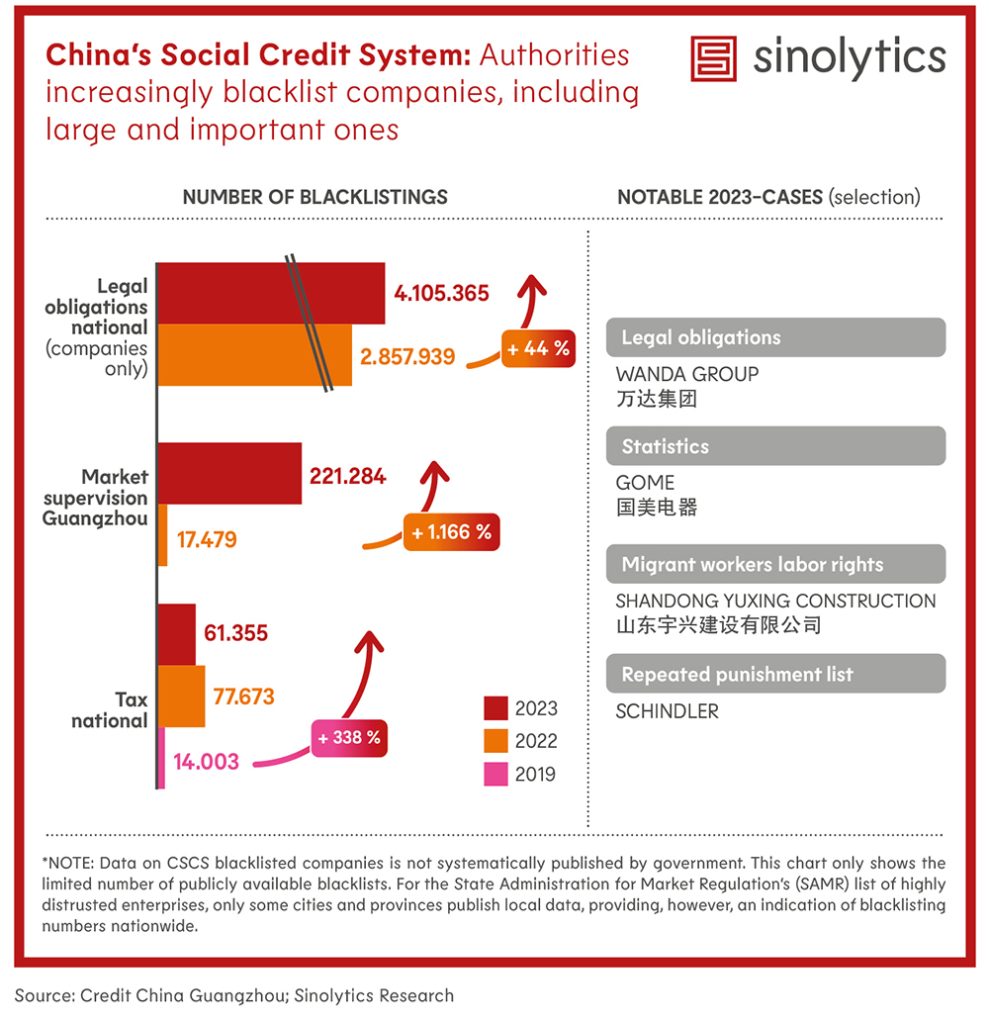
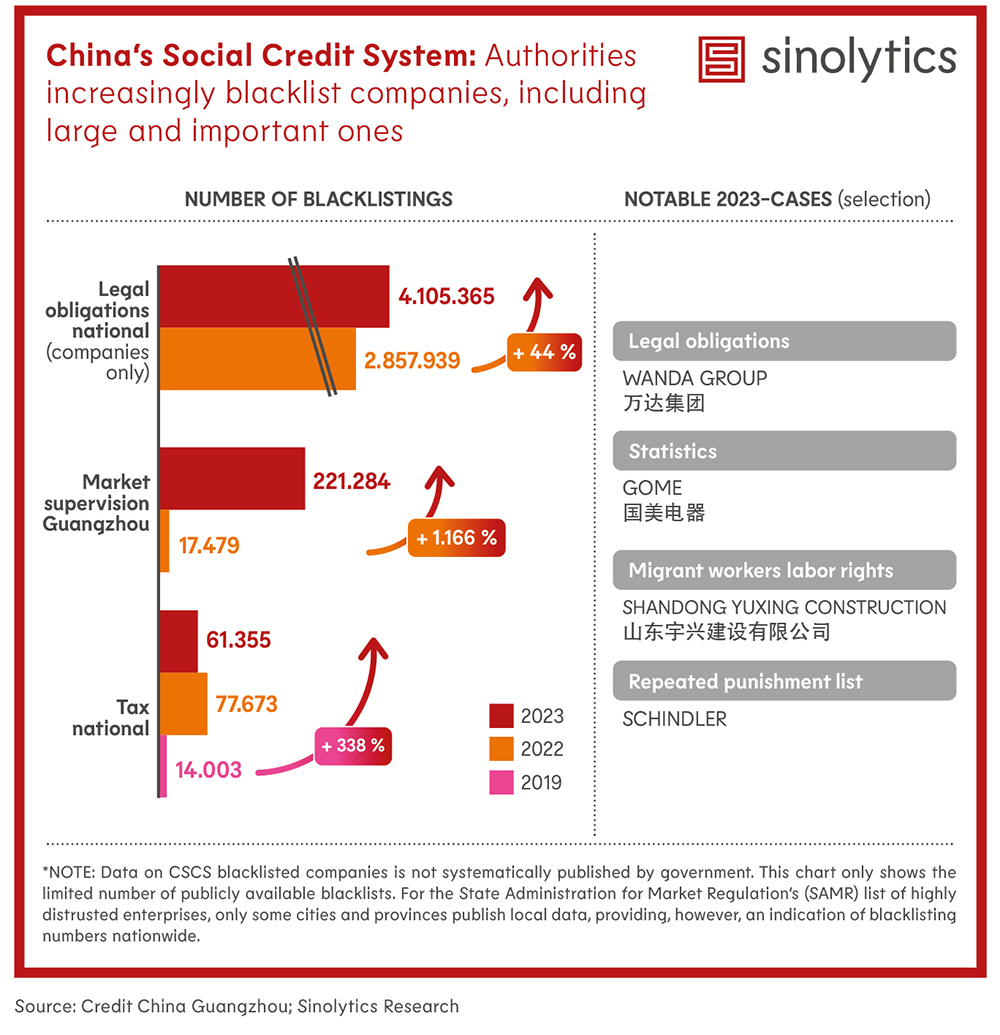
Sinolytics is a research-based business consultancy entirely focused on China. It advises European companies on their strategic orientation and specific business activities in the People’s Republic.
China has ignored Germany’s questions regarding the boarding school system in Tibet at the UN Human Rights Council in Geneva. The representatives of the People’s Republic did not answer the question on the percentage of Tibetan children in boarding schools, nor did they explain the consequences for families who refuse to enroll their children. Instead, China’s ambassador in Geneva, Chen Xu, described the accusations of a systematic eradication of Tibetan culture as fabricated and ideologically motivated.
In the three-and-a-half-hour session of the Universal Periodic Review, 160 countries took the opportunity to give their recommendations to China on how to improve the human rights situation in the country in 45 seconds each. In addition to abolishing the internment system, the German representation also recommended ending worker transfer programs in Xinjiang, fully restoring the rule of law in Hong Kong and releasing arbitrarily detained human rights defenders in the People’s Republic.
“We very much welcome the German statement,” said Kai Mueller, Executive Director of the International Campaign for Tibet (ICT). Mueller was “very encouraged” by the significant increase in the number of states criticizing China’s human rights violations before the committee. Around 15 NGO representatives were admitted to the meeting – significantly fewer than in the past. According to the ICT, the review took place in a tense atmosphere “as the Chinese government was present with an unusually large delegation of more than 40 diplomats”. Beijing also mobilized a significant number of Chinese NGOs (GONGOs – Government Organized NGOs), “which strictly follow the party line.”
The final reports of the review process will be published in the coming weeks. The results will be discussed again before the Council in June. Human rights organizations will also be able to comment on China’s statement and ask further questions. grz
China has resumed voluntary trading in carbon credits (Chinese Certified Emissions Reductions/CCER). The revised CCER system allows any company to purchase carbon credits – not just the energy companies currently participating in China’s emissions trading system (ETS).
Initially, only credits for projects approved before 2017 can be traded at the China Beijing Green Exchange, as Bloomberg reports. However, new projects are expected to be approved for the system. According to a conservative estimate by local investment bank Minsheng Securities, the CCER spot market will reach a volume of around 20 billion yuan (2.56 billion euros) by 2025.
CCERs verify climate action projects of ETS companies to offset their emissions, for example, through investments in renewables, carbon sinks, or the use of methane. Projects from solar thermal energy, offshore wind power, reforestation and mangrove restoration will also be eligible in the future. Under the CCER, each credit corresponds to one ton of reduced CO2 emissions.
China launched the CCER system in 2012; between 2013 and 2017, credits were issued for 287 projects, primarily for wind energy, photovoltaics and the use of biogas in rural areas. In March 2017, China suspended issuing new credits due to low transaction volumes and a lack of standards for CO2 auditing. However, trading of existing credits was still possible.
In China’s emissions trading system (ETS), companies can offset up to five percent of their compliance obligations with such CCERs. The ETS, launched in mid-2021, is only mandatory for the energy sector but will soon be extended to heavy industry. The average price of CO2 in the ETS has increased from 43 yuan per ton since the start of trading in mid-2021 to 68 yuan per ton at the end of 2023. However, the price difference compared to the EU emissions trading system is still considerable, and there are occasional problems with the submitted emissions data. ck
On Tuesday, Chinese shares recovered from their slump after the government signaled support for the battered markets. The Chinese cabinet announced strong and effective measures on Monday. Bloomberg reported, citing unnamed sources, that policymakers were trying to mobilize about two trillion yuan (260 billion euros) to stabilize the struggling stock markets.
On Tuesday morning, the Shanghai Composite had reached its lowest level in four years, but eventually closed up slightly. The blue-chip index CSI 300 also closed up slightly, while the Hang Seng Index (HSI) in Hong Kong even posted its biggest daily gain in two months.
All three indices, which have been lagging behind the global markets for years, performed poorly in January. The Chinese CSI 300 Index dropped by 47 percent since its peak in February 2021. It tracks the performance of the two largest stock exchanges in mainland China, Shanghai and Shenzhen. The HSI, one of the most important indices in Asia, fell by 49 percent. cyb
China’s domestic smartphone market has slightly recovered in 2023. A total of 289 million smartphones were sold on the Chinese domestic market, compared to 272 million in the previous year, according to the China Academy of Information and Communications Technology (CAICT), part of the Ministry of Industry and Information Technology, on Tuesday. This represents a growth of 6.5 percent.
According to a South China Morning Post report, the year was also characterized by growing competition and Huawei’s strong comeback in the 5G segment. Among other things, Huawei launched the 5G-ready Mate 60 Pro, equipped with a domestically manufactured high-performance chip.
In 2022, the market collapsed by 22.6 percent. Despite the recovery, unit sales in 2023 have not yet reached the delivery volume of 2021, when 351 million smartphones were sold. ck
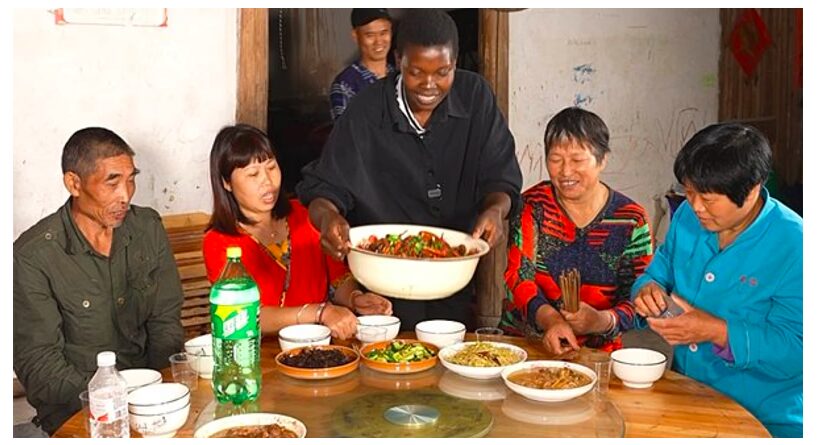
There are many influencers who present rural China as an idyllic place. But Rose Mary Adikin – or Rose, as she is simply known – is a unique figure in the People’s Republic’s lucrative streaming and vlogging sphere simply because of her origins. The 30-year-old from Uganda has settled in a village in the eastern Chinese province of Zhejiang. Here, she shoots videos in perfect Mandarin with a local dialect, which have taken the Chinese internet by storm. Viewers are particularly fascinated by her cooking skills. She masters Chinese classics such as stinky tofu or roasted duck, just like her homeland’s popular jollof rice.
Love brought her to China. In 2014, Rose fell in love with Chinese chef Wu Jianyun and moved to Suichang County with him. Their son Wu Zian was born in 2016. She only started vlogging about her “Sino-Africa rural love story” in 2021. Since then, viewer numbers have been rising steadily – millions of viewers on Chinese video platforms such as Douyin, but also on YouTube and TikTok, where her English subbed videos have been viewed once by more than 360,000 and even 1.2 million people.
Rose’s story shows how Africa and China are growing together, not only economically, but also culturally. Rose met her husband through a superior while still working in a Chinese-run furniture factory in Uganda. In July 2023, the Chinese news agency Xinhua and Ugandan media reported on her first trip back to her home country after six years.
At first glance, the public marriage between Rose and Wu is a win-win cooperation, as Beijing would put it in New Silk Road terminology. For Uganda, where China is economically involved, like in many other African countries, Rose is a soft power ambassador. And the Chinese can admire the magnificence and uniqueness of their own culture through her eyes. Western influencers who present China in a positive light have been popular in the People’s Republic for years. However, African voices are still a rarity in the chorus of “foreign friends.”
Social media apps such as Douyin shape the Chinese perception of Africa even more than traditional media. According to a study by the Africa-China Reporting Project from the Wits Centre for Journalism at the University of Witwatersrand in Johannesburg, stereotypes of poverty and exotic, wild beauty are often repeated. Media and academic discourses on racism, as we know them in the West, are hardly discussed in China. Racism is often portrayed as a “Western problem.” Yet it often shows itself – especially in subtle form – in the videos of Chinese vloggers who live in or visit Africa, as the journalists from Johannesburg have analyzed.
It found that terms such as “African 非洲人” and “Blacks 黑人” are often used synonymously. Black women are often referred to as “black rose 黑玫瑰” or “black pearl 黑珍珠,” and different skin tones are compared based on their beauty. Particularly popular are channels such as 小鱼酱酱酱酱, where Africans sing Chinese songs. As with white foreigners in the past, black Africans are also considered somehow surprising and flattering when they speak very good Chinese. Conversely, however, hardly any Chinese vloggers speak an African language. The power imbalance is obvious.
Videos of philanthropic Chinese are also not uncommon. They give away money or gifts in African countries and film the joy and gratitude of the locals. Comments like: “I’m glad I was born in China” are often posted under such videos. Or: “Looks like China in the 70s or 80s.” In this respect, these videos reflect on a small scale what the state-owned media report about big infrastructure projects in Africa, namely that they are met with huge gratitude in Africa.
Rose herself had never experienced any hostility, she told Chinese media. On the contrary, she said she was welcomed with open arms everywhere. 80 percent of her viewers are female and between the ages of 30 and 50. She now has five employees who help her showcase her life. She has sponsorship deals and gave a speech on tourism and humanity at the third BRI Forum. Her videos are expectedly unpolitical. But sometimes, she teases her husband: “You need to start working on your English.” Fabian Peltsch
Marc Horn has been President of Merck China since January. He joined Merck in 2014, first as CFO for China, then as CFO for East Asia and as Managing Director of the Healthcare business in China. He has been part of the Merck Life Science Executive Leadership Team since 2017, most recently as Chief Transformation Officer.
Seth Tan has been appointed new Head of Corporate Banking in China at Singapore-based financial services provider OCBC. He succeeds Ang Eng Siong, who has been Chief Executive of OCBC China since last November 2023.
Is something changing in your organization? Let us know at heads@table.media!

Geopolitics at the Oscars – the short film “Island in Between” about the island of Kinmen has been nominated for the film industry’s most prestigious award. The film by director S. Leo Chiang has been nominated for Best Documentary Short Film. In it, Chiang explores the island’s unique characteristics, which lies in the Taiwan Strait just off the coast of mainland China, overlooking the city of Xiamen. Chiang also weaves in his personal life story: He was born in Taiwan and grew up in the United States. He says about his work: “At this moment, as we struggle to make sense of the horrors of war, I hope this documentary can play a small part in advocating for peace.”
Canada continues its climate efforts. At the end of last year, the government decided to ban cars with combustion engines in 2035. A quota for electric cars will already be introduced before then. What is good for global warming is also good for Chinese EV manufacturers, writes Christian Domke Seidel. After all, they offer the affordable cars that have so far been lacking in Canada.
And BYD, NIO & Co. can gain a foothold in the North American market via Canada, where they do not have to fear punitive tariffs on their products. This also shows that the more pioneering competition benefits when the domestic industry does not manufacture the products required for the climate transition.
The Maldives are currently breaking new ground with their alliance partners. The island nation has traditionally felt close to India, but it is now turning to China under its new president, Mohamed Muizzu. This is an enormous geostrategic win for the People’s Republic, as the atolls of the Maldives lie on an underwater ridge that forms a kind of wall in the middle of the Indian Ocean, offering massive potential for controls and blockades, as Michael Radunski explains.
China has lent so much money to the archipelago that it is now its largest bilateral creditor. Its repositioning proves that the investment has paid off.


The Maldives has a new strategic partner: China. For years, the small island state in the Indian Ocean maintained close ties to neighboring India. Now, however, Malé looks to the much more distant People’s Republic. This is an important geostrategic gain for China. The Maldives may be small, but they play an important role in the race for influence in the Indian Ocean.
The driving force behind the shift towards China is Mohamed Muizzu. The 45-year-old has been President of the Maldives for a few months now. His election campaign slogan was: India out. Muizzu claimed that Delhi’s traditionally strong influence threatened his country’s sovereignty.
The new president is now putting his words into action – and breaking old traditions in the process. Instead of first traveling to India, he preferred to visit China in early January. In the port city of Fuzhou, he campaigned for investment and called China one of his “closest allies and development partners.” The meeting with party and state leader Xi Jinping resulted in 20 agreements and a comprehensive strategic partnership.
Muizzu’s main focus in China was on:
Shortly after Muizzu’s China trip, his next insult to Delhi came in the form of an ultimatum: India’s military forces, after being stationed in the Maldives for years, must leave the country by mid-March.
This new close partnership is an enormous geostrategic gain for Beijing. This may seem surprising at first glance: The Maldives is the smallest Asian country with a total land area of just 300 square kilometers and a population of just 480,000. However, its atolls are located on a 960-kilometer-long underwater ridge stretching from north to south.
This makes the Maldives a kind of wall in the middle of the Indian Ocean – with enormous control and blockade potential. Some of the most important international shipping routes run through its exclusive economic zone: sea routes crucial for trade between the Gulf of Aden and the Gulf of Hormuz in West Asia and the Strait of Malacca in South East Asia. Among other things, oil is transported here from the Middle East to Asia – to Japan and, above all, to China.

“The Indian Ocean is far from us, but it’s extremely important to the economic and energy security of our country, as well as the Belt and Road Initiative,” Zhao Gancheng from the Shanghai Institute for International Studies told the Chinese Global Times. Since the Maldives joined China’s maritime Silk Road in 2014, companies from the People’s Republic have invested almost 1.4 billion US dollars in the small island nation. This also explains Muizzu’s first stop on his trip to China: Fuzhou is the starting point of China’s Maritime Silk Road.
Chinese loans financed the expansion of the power grid and the international airport, the construction of thousands of homes and a kilometer-long bridge. “The Maldives-China Friendship Bridge, a dream project to local residents over half a century, has become a symbol for the friendliness between the two countries, which has changed the daily lives of Maldivians,” rejoices the Chinese Global Times. According to Reuters, the Maldives now owes China 1.37 billion US dollars for the project. This makes the People’s Republic the island nation’s largest bilateral creditor, ahead of Saudi Arabia and India.
Beijing now aims to play the role of the big ally. This change is very well received there. Xi called Muizzu an “old friend.” As proof of the supposedly long relationship, a commentary by the state news agency Xinhua even refers to navigator Zheng He, whose ships docked in the Maldives during the Ming dynasty. However, Beijing only opened an embassy in the Maldives at the end of 2011 – amid significant domestic political unrest. At that time, it was only possible to restore public order with the help of the Indian military.
Meanwhile, the rejection of Delhi has affected one of the Maldives’ most important industries: tourism. The hashtags #BoycottMaldives and #ExploreIndianIslands are used in India to encourage people to spend their holidays in India instead of in the Maldives. Prime Minister Narendra Modi praised the beauty of Indian beaches earlier this month. The online travel booking company EaseMyTrip has already removed the Maldives from its program. “We’ve put nation before business,” said Prashant Pitti, co-founder of EaseMyTrip, in a television interview. “This is a proxy war between India and China.”
The stakes are high, as most tourists came from India in 2023, accounting for 11.2 percent of all tourists, according to data from the Ministry of Tourism. Followed by Russians and Chinese. However, before the COVID-19 pandemic, travelers from China led the rankings. If President Muizzu has his way, this will be the case again as soon as possible.
From Malé’s perspective, the rapprochement with Beijing has perfectly understandable reasons: The Maldives lost its status as a developing country in 2012. The consequence: The country could no longer rely on international aid for its development plans. While many countries hesitated, Beijing recognized its opportunity.
“The Maldives is trying to get the best out of the rivalry between India and China,” Rajeswari Rajagopalan told Table.Media. “The Maldives is doing what every small player does when you have two big powers in the neighborhood: play them off against each other to get the best deal. It’s a well-known strategy,” explains the researcher from the Observer Research Foundation in Delhi.
Sri Lanka is also located in this neighborhood – a country that has also turned away from India and towards China. Experts criticize China for using its loans to lure Sri Lanka into a debt trap to make the country economically and politically dependent. The World Bank warns that the Maldives’ debt is now unsustainably high.

In 2035, new cars that run on gasoline or diesel can no longer be sold in Canada. Due to the lack of domestic alternatives, Chinese manufacturers could close the supply gap. They offer what Canadian customers want: affordable electric cars. BYD has the best chance of gaining a substantial market share.
In late 2023, Canadian Environment Minister Steven Guilbeault presented a law that will ban the sale of new cars with diesel or gasoline engines starting in 2035. The Electric Vehicle Availability Standard serves as a kind of guide for car manufacturers with predefined quotas. By 2026, every fifth vehicle sold is to be purely electric. The percentage then increases continuously: 23 percent in 2027, 60 percent in 2030 and 100 percent in 2035. “Two provinces are already above the 20 percent threshold – Quebec and British Columbia,” Guilbeault said
According to the Canadian Vehicle Information System (CVSI), Canadians bought a total of around 1.8 million cars in 2023. Electric cars accounted for just 12 percent of new registrations. One reason for the low share is the price. The Canadian Black Book – a mobility data provider in Canada – reports that the average price of a new car last year was 66,000 Canadian dollars (around 45,000 euros) but, prices for an EV averaged 73,000 dollars (about 49,700 euros).
John Fanjoy, an analyst at Scotiabank, explains in an interview with the Canadian Broadcasting Corporation (CBC): “We found that vehicle prices would need to come down by about a third to even half of what they are today, in relative purchasing power terms, in order for electric vehicles to be affordable mass market.” The high average price is also because American and European manufacturers mainly offer EVs in the premium segment.
The situation is different in China, where BYD, for instance, targets the volume segment with its EVs. And this is precisely why the Canadian law on phasing out combustion engines has many dealerships and representatives of the North American automotive industry worried. Flavio Volpe, President of the Canadian Automotive Parts Manufacturers’ Association, called the plans unachievable: The Canadian government doesn’t care whether the cars come from Canada or China. He believes that the legislative initiative is harmful to the Canadian industry.
Noel Hiscox, President of the Canadian automotive consultancy Clarify Group, spoke more cautiously to CBC, but no less clearly. There is a chance that the need to change quickly will open up the market for Chinese manufacturers in a way that would not happen with a slower approach.
So far, the Canadian car market has been heavily dependent on the United States – around three-quarters of new cars come from there. This is also reflected in the registrations. The best-selling vehicles are SUVs (711,000) and pickups (387,000), with the most popular brands being Honda, Toyota, Ford, Hyundai and Chevrolet. Most of them are being manufactured in the United States.
However, even before the combustion engine ban, Chinese car manufacturers recognized the opportunity the Canadian market offers them. While the United States imposes a 25 percent punitive tariff on assembled Chinese cars, this does not apply in Canada. Although Tesla models from Shanghai have primarily been exported to Canada so far, BYD and NIO have also been ready for a long time.
Although the manufacturers tend to be tight-lipped when speaking to Table.Media, a NIO representative made it clear with regard to Canada: “As a global smart EV company, NIO is continuously looking at expanding into other markets, which of course includes North America.”
BYD is already one step ahead. The company, which recently replaced Tesla as the world’s largest EV manufacturer, has already built a plant for electric buses in Ontario in 2023. Ted Dowling, Vice President of BYD Canada, showed hardly any reservations during its opening. “We’re proud to establish a home in Canada; it re-affirms our commitment as a company to be rooted in this country and in this province.”
Canada plays a vital role in the efforts of many companies and countries to become less dependent on China. The country has an abundance of lithium, cobalt, nickel and graphite. Mercedes and VW have already signed a memorandum of understanding to examine the extent to which Canada can help build a global battery supply chain.
Honda has also knocked on Canada’s door and plans to invest the equivalent of 12.5 billion euros to build a battery and EV plant in Canada. Production is scheduled to begin in 2028. In addition, Northvolt, Volkswagen and Stellantis have pledged investments of around 25 billion euros over the next ten years.
Yasutoshi Nishimura, Japan’s Minister of Trade and Industry, also visited Canada in 2023 to agree on closer cooperation in the field of electromobility. A meeting that focused primarily on Canada’s natural resources.


Sinolytics is a research-based business consultancy entirely focused on China. It advises European companies on their strategic orientation and specific business activities in the People’s Republic.
China has ignored Germany’s questions regarding the boarding school system in Tibet at the UN Human Rights Council in Geneva. The representatives of the People’s Republic did not answer the question on the percentage of Tibetan children in boarding schools, nor did they explain the consequences for families who refuse to enroll their children. Instead, China’s ambassador in Geneva, Chen Xu, described the accusations of a systematic eradication of Tibetan culture as fabricated and ideologically motivated.
In the three-and-a-half-hour session of the Universal Periodic Review, 160 countries took the opportunity to give their recommendations to China on how to improve the human rights situation in the country in 45 seconds each. In addition to abolishing the internment system, the German representation also recommended ending worker transfer programs in Xinjiang, fully restoring the rule of law in Hong Kong and releasing arbitrarily detained human rights defenders in the People’s Republic.
“We very much welcome the German statement,” said Kai Mueller, Executive Director of the International Campaign for Tibet (ICT). Mueller was “very encouraged” by the significant increase in the number of states criticizing China’s human rights violations before the committee. Around 15 NGO representatives were admitted to the meeting – significantly fewer than in the past. According to the ICT, the review took place in a tense atmosphere “as the Chinese government was present with an unusually large delegation of more than 40 diplomats”. Beijing also mobilized a significant number of Chinese NGOs (GONGOs – Government Organized NGOs), “which strictly follow the party line.”
The final reports of the review process will be published in the coming weeks. The results will be discussed again before the Council in June. Human rights organizations will also be able to comment on China’s statement and ask further questions. grz
China has resumed voluntary trading in carbon credits (Chinese Certified Emissions Reductions/CCER). The revised CCER system allows any company to purchase carbon credits – not just the energy companies currently participating in China’s emissions trading system (ETS).
Initially, only credits for projects approved before 2017 can be traded at the China Beijing Green Exchange, as Bloomberg reports. However, new projects are expected to be approved for the system. According to a conservative estimate by local investment bank Minsheng Securities, the CCER spot market will reach a volume of around 20 billion yuan (2.56 billion euros) by 2025.
CCERs verify climate action projects of ETS companies to offset their emissions, for example, through investments in renewables, carbon sinks, or the use of methane. Projects from solar thermal energy, offshore wind power, reforestation and mangrove restoration will also be eligible in the future. Under the CCER, each credit corresponds to one ton of reduced CO2 emissions.
China launched the CCER system in 2012; between 2013 and 2017, credits were issued for 287 projects, primarily for wind energy, photovoltaics and the use of biogas in rural areas. In March 2017, China suspended issuing new credits due to low transaction volumes and a lack of standards for CO2 auditing. However, trading of existing credits was still possible.
In China’s emissions trading system (ETS), companies can offset up to five percent of their compliance obligations with such CCERs. The ETS, launched in mid-2021, is only mandatory for the energy sector but will soon be extended to heavy industry. The average price of CO2 in the ETS has increased from 43 yuan per ton since the start of trading in mid-2021 to 68 yuan per ton at the end of 2023. However, the price difference compared to the EU emissions trading system is still considerable, and there are occasional problems with the submitted emissions data. ck
On Tuesday, Chinese shares recovered from their slump after the government signaled support for the battered markets. The Chinese cabinet announced strong and effective measures on Monday. Bloomberg reported, citing unnamed sources, that policymakers were trying to mobilize about two trillion yuan (260 billion euros) to stabilize the struggling stock markets.
On Tuesday morning, the Shanghai Composite had reached its lowest level in four years, but eventually closed up slightly. The blue-chip index CSI 300 also closed up slightly, while the Hang Seng Index (HSI) in Hong Kong even posted its biggest daily gain in two months.
All three indices, which have been lagging behind the global markets for years, performed poorly in January. The Chinese CSI 300 Index dropped by 47 percent since its peak in February 2021. It tracks the performance of the two largest stock exchanges in mainland China, Shanghai and Shenzhen. The HSI, one of the most important indices in Asia, fell by 49 percent. cyb
China’s domestic smartphone market has slightly recovered in 2023. A total of 289 million smartphones were sold on the Chinese domestic market, compared to 272 million in the previous year, according to the China Academy of Information and Communications Technology (CAICT), part of the Ministry of Industry and Information Technology, on Tuesday. This represents a growth of 6.5 percent.
According to a South China Morning Post report, the year was also characterized by growing competition and Huawei’s strong comeback in the 5G segment. Among other things, Huawei launched the 5G-ready Mate 60 Pro, equipped with a domestically manufactured high-performance chip.
In 2022, the market collapsed by 22.6 percent. Despite the recovery, unit sales in 2023 have not yet reached the delivery volume of 2021, when 351 million smartphones were sold. ck

There are many influencers who present rural China as an idyllic place. But Rose Mary Adikin – or Rose, as she is simply known – is a unique figure in the People’s Republic’s lucrative streaming and vlogging sphere simply because of her origins. The 30-year-old from Uganda has settled in a village in the eastern Chinese province of Zhejiang. Here, she shoots videos in perfect Mandarin with a local dialect, which have taken the Chinese internet by storm. Viewers are particularly fascinated by her cooking skills. She masters Chinese classics such as stinky tofu or roasted duck, just like her homeland’s popular jollof rice.
Love brought her to China. In 2014, Rose fell in love with Chinese chef Wu Jianyun and moved to Suichang County with him. Their son Wu Zian was born in 2016. She only started vlogging about her “Sino-Africa rural love story” in 2021. Since then, viewer numbers have been rising steadily – millions of viewers on Chinese video platforms such as Douyin, but also on YouTube and TikTok, where her English subbed videos have been viewed once by more than 360,000 and even 1.2 million people.
Rose’s story shows how Africa and China are growing together, not only economically, but also culturally. Rose met her husband through a superior while still working in a Chinese-run furniture factory in Uganda. In July 2023, the Chinese news agency Xinhua and Ugandan media reported on her first trip back to her home country after six years.
At first glance, the public marriage between Rose and Wu is a win-win cooperation, as Beijing would put it in New Silk Road terminology. For Uganda, where China is economically involved, like in many other African countries, Rose is a soft power ambassador. And the Chinese can admire the magnificence and uniqueness of their own culture through her eyes. Western influencers who present China in a positive light have been popular in the People’s Republic for years. However, African voices are still a rarity in the chorus of “foreign friends.”
Social media apps such as Douyin shape the Chinese perception of Africa even more than traditional media. According to a study by the Africa-China Reporting Project from the Wits Centre for Journalism at the University of Witwatersrand in Johannesburg, stereotypes of poverty and exotic, wild beauty are often repeated. Media and academic discourses on racism, as we know them in the West, are hardly discussed in China. Racism is often portrayed as a “Western problem.” Yet it often shows itself – especially in subtle form – in the videos of Chinese vloggers who live in or visit Africa, as the journalists from Johannesburg have analyzed.
It found that terms such as “African 非洲人” and “Blacks 黑人” are often used synonymously. Black women are often referred to as “black rose 黑玫瑰” or “black pearl 黑珍珠,” and different skin tones are compared based on their beauty. Particularly popular are channels such as 小鱼酱酱酱酱, where Africans sing Chinese songs. As with white foreigners in the past, black Africans are also considered somehow surprising and flattering when they speak very good Chinese. Conversely, however, hardly any Chinese vloggers speak an African language. The power imbalance is obvious.
Videos of philanthropic Chinese are also not uncommon. They give away money or gifts in African countries and film the joy and gratitude of the locals. Comments like: “I’m glad I was born in China” are often posted under such videos. Or: “Looks like China in the 70s or 80s.” In this respect, these videos reflect on a small scale what the state-owned media report about big infrastructure projects in Africa, namely that they are met with huge gratitude in Africa.
Rose herself had never experienced any hostility, she told Chinese media. On the contrary, she said she was welcomed with open arms everywhere. 80 percent of her viewers are female and between the ages of 30 and 50. She now has five employees who help her showcase her life. She has sponsorship deals and gave a speech on tourism and humanity at the third BRI Forum. Her videos are expectedly unpolitical. But sometimes, she teases her husband: “You need to start working on your English.” Fabian Peltsch
Marc Horn has been President of Merck China since January. He joined Merck in 2014, first as CFO for China, then as CFO for East Asia and as Managing Director of the Healthcare business in China. He has been part of the Merck Life Science Executive Leadership Team since 2017, most recently as Chief Transformation Officer.
Seth Tan has been appointed new Head of Corporate Banking in China at Singapore-based financial services provider OCBC. He succeeds Ang Eng Siong, who has been Chief Executive of OCBC China since last November 2023.
Is something changing in your organization? Let us know at heads@table.media!

Geopolitics at the Oscars – the short film “Island in Between” about the island of Kinmen has been nominated for the film industry’s most prestigious award. The film by director S. Leo Chiang has been nominated for Best Documentary Short Film. In it, Chiang explores the island’s unique characteristics, which lies in the Taiwan Strait just off the coast of mainland China, overlooking the city of Xiamen. Chiang also weaves in his personal life story: He was born in Taiwan and grew up in the United States. He says about his work: “At this moment, as we struggle to make sense of the horrors of war, I hope this documentary can play a small part in advocating for peace.”
